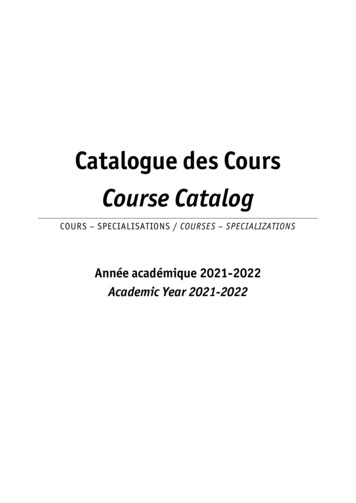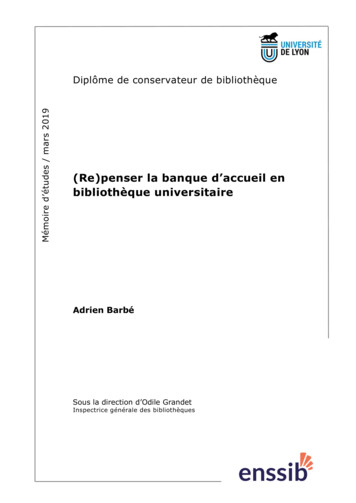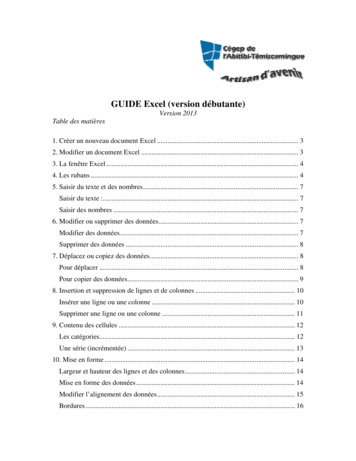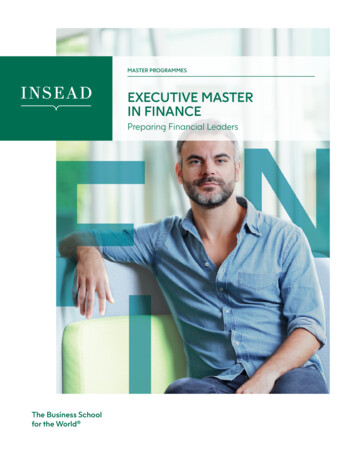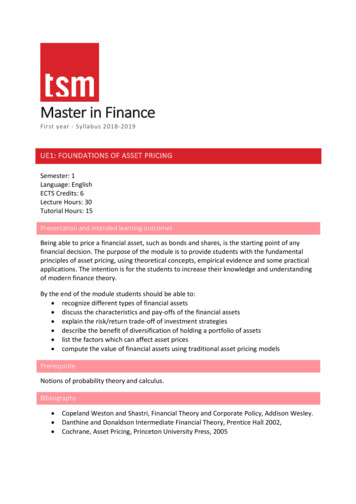
Transcription
Master in FinanceFirst year - Syllabus 2018-2019UE1: FOUNDATIONS OF ASSET PRICINGSemester: 1Language: EnglishECTS Credits: 6Lecture Hours: 30Tutorial Hours: 15Presentation and intended learning outcomesBeing able to price a financial asset, such as bonds and shares, is the starting point of anyfinancial decision. The purpose of the module is to provide students with the fundamentalprinciples of asset pricing, using theoretical concepts, empirical evidence and some practicalapplications. The intention is for the students to increase their knowledge and understandingof modern finance theory.By the end of the module students should be able to: recognize different types of financial assets discuss the characteristics and pay-offs of the financial assets explain the risk/return trade-off of investment strategies describe the benefit of diversification of holding a portfolio of assets list the factors which can affect asset prices compute the value of financial assets using traditional asset pricing modelsPrerequisiteNotions of probability theory and calculus.Bibliography Copeland Weston and Shastri, Financial Theory and Corporate Policy, Addison Wesley.Danthine and Donaldson Intermediate Financial Theory, Prentice Hall 2002,Cochrane, Asset Pricing, Princeton University Press, 2005
UE2: INTRODUCTION TO CORPORATE VALUATIONSemester: 1Language: EnglishECTS Credits: 6Lecture Hours: 30Tutorial Hours: 15Presentation and intended learning outcomesThis course is about how corporations make financial decisions. Topics include asset valuation,capital budgeting, cost of capital, financial reading of accounting statements, capital structure,profit ratios, value creation and price-earnings ratio. Students will learn core concepts andtools to make investment decision and maximize value.By the end of the module, students should be able to: recognize key financial indicators from financial statements identify appropriate financial criteria for corporate valuation and investment decisions calculate the value implications of investment decisionsPrerequisiteAccounting basics.Bibliography Corporate Finance, Jonathan Berk and Peter DeMarzo, Pearson International EditionManagerial Finance, 9th edition, J. Fred Weston and Thomas E. Copeland, The DrydenPressUE3-1: MATHEMATICS FOR FINANCE AND INSURANCE (OPTIMIZATION)Semester: 1Language: EnglishECTS Credits: 3Lecture Hours: 15Tutorial Hours: 7.5Presentation and intended learning outcomesThe purpose of the lectures is to give the mathematical foundations of analysis andoptimization needed to present modern and classical economic theory as e.g. optimalconsumption problems.By the end of the course, students should be able to: explain the main features of multivariate functions
solve simple problems of constrained optimizationutilize optimization methods in selected finance applicationsPrerequisiteBasic mathematical calculus, including derivative and maximisation/minimisation of a functionof one variable.Bibliography Simon, Blume: Mathematics for Economists, Norton and Company (June 8, 1994)Anthony, Biggs: Mathematics for Economics and Finance: Methods and Modelling,Cambridge University Press; 1 edition (July 13, 1996)Binmore, Davies: Calculus: Concepts and Methods, Cambridge University Press; 2RevEd edition (Feb. 7, 2002)UE3-2: MATHEMATICS FOR FINANCE AND INSURANCE (PROBABILITY)Semester: 1Language: EnglishECTS Credits: 3Lecture Hours: 15Tutorial Hours: 7.5Presentation and intended learning outcomesThe purpose of this lecture is to give the mathematical foundations (Probability theory)needed to present modern finance theory, includingMathematical theory of Risk, Portfolio theory, Capital Asset Pricing Model, option pricing, etc.By the end of the course, students should be able to: describe the concept of probability and stochastic variable compute the main moments of stochastic variables utilize probability theory in selected finance applicationsPrerequisiteBasic mathematical calculus, including derivative and integration.Bibliography Konrad Menzel: Introduction to statistical methods in economics(MIT Open Course Ware: 009/)Robert B. Ash: Basic probability theoryJacod Protter: Probability essentials Springer
UE4: BUSINESS ECONOMICSSemester: 1Language: EnglishECTS Credits: 6Lecture Hours: 30Tutorial Hours: 15Presentation and intended learning outcomesIn this course, students will learn to analyze firm’s decisions by applying principles ofeconomic analysis. Using the rational behavior paradigm, we will study how firms shouldaccount for their environment—both the nature of consumer demand and the structure ofrival competition—when choosing strategic variables such as price, competition, and quality.We will also discuss topics relating to contractual relationships either between firms (verticalrestraints, mergers) or within the firm (principal-agent theory).By the end of the module students should be able to: describe the economic foundations for decision making in finance, notably theappreciation of risk explain the economic methodology used to analyze situations of strategic interaction(game theory) solve simple problems of strategic interaction appraise how firms interact strategically in product marketsPrerequisiteBasic Mathematical knowledgeBibliography Managerial Economics and Business Strategy, M.R. Baye, Mac Graw-Hill Irvin editorIntroduction to Industrial Organization, L. Cabral, M.I.T. PressThe Economics of Strategy, D. Besanko, Wiley editorUE5: INTRODUCTION TO FINANCIAL ACCOUNTING AND REPORTINGSemester: 1Language: EnglishECTS Credits: 4Lecture Hours: 15Tutorial Hours: 7.5
Presentation and intended learning outcomesThe increase in the internationalization of many industries in recent years has led to animportant increase in the number of companies operating globally. Knowledge of internationalaccounting rules is thus becoming increasingly important for the accounting and financeprofessionals.By the end of this course, students should be able to: explain the main accounting principles and mechanisms read and analyze financial statements describe and apply some basic international accounting standardsPrerequisiteGeneral accounting background.Bibliography J. Kothari, E. Barone, Advanced financial accounting: An international approach,Prentice Hall, 2010.H. Stolowy, M. Lebas, Financial accounting and reporting: A global perspective,Thomson, 2006.B. Elliott, J. Elliott, Financial accounting and reporting, Prentice Hall, 2007.D. Cootter, Advances financial reporting: A complete guide to IFRS, Prentice Hall, 2012.Vernimmen, Corporate Finance: Theory and Practice, John Wiley & Sons Inc.IAS Plus WebsiteUE6: INITIATION TO RESEARCHSemester: 1Language: EnglishECTS Credits: 2Lecture Hours: 12Presentation and intended learning outcomesThe capacity to innovate has become a critical skill for the 21st century business person andentrepreneur operating in an ever more complicated and faster changing world. Designthinking and innovative problem-solving use deep theoretical understanding, problemframing, a range of ideation techniques, and critique to generate and develop implementableconcepts. This is what is research. This course is a first research-course oriented at the Masterlevel and provide an opportunity for students to establish your understanding of researchthrough critical exploration of research language, ethical principles and challenges, and theelements of a research design.Participating in Introduction to Research in Finance will allow you to: Understand research terminology;
Discover to critically review literature relevant to your field or interests;Determine how research findings are useful in forming your understanding of yourwork;Design a project which tests essential frameworks, and which enables modelling of keytheories;Develop a research methodology which enables accurate representation of key themesand ideas within the field of finance;Be aware of the ethical principles of research, ethical challenges and approvalprocesses.Engage with like-minded peers to take control of your own research plans and ideasPrerequisiteNone.UE7-1: FINANCIAL MARKETS (INTRODUCTION TO DERIVATIVES)Semester: 2Language: EnglishECTS Credits: 3Lecture Hours: 15Tutorial Hours: 15Presentation and intended learning outcomesModern managers can use financial derivatives such as futures, options, and swaps to hedgeparticular kinds of risk or to change the returns on their portfolios in certain ways. Thepurpose of this course is to provide the student with the necessary preliminary skills to valuesimple forward contracts and plain vanilla options by arbitrage. In order to provide a usefultreatment of these topics it is necessary to stress fundamentals and to explore topics at asomewhat technical level.By the end of this course, students should be able to: understand what these derivative instruments are understand how these derivative instruments may be used to manage risks or designdirectional strategies price simple forward contracts on financial assets by arbitrage price a European call or put option in the binomial model of Cox-Ross-Rubinstein use Black Merton Scholes formula to price a European call or put optionPrerequisiteThis course is a technical course. Students are expected to have a minimum preparation inprobability theory (random variables, expectation, conditional expectation, binomialdistribution, normal distribution) and statistics.
Bibliography Derivatives Markets (3nd edition), by Robert L McDonald.Options, Futures and Other Derivatives (11th edition), by John C Hull.UE7-2: FINANCIAL MARKETS (ORGANIZATION OF FINANCIAL MARKETS AND FIXEDINCOME)Semester: 2Language: EnglishECTS Credits: 3Lecture Hours: 15Tutorial Hours: 7.5Presentation and intended learning outcomesThis course will provide an extensive introduction to financial markets and its environment.The main objectives are to give an overview of all asset classes and the different financialsinstruments (stocks, bonds, derivatives), to review the regulation of financial markets andtheir participants, and to understand the functioning of some key markets.By the end of this course, students should be able to: explain the main functions of financial markets list the main financial markets and market participants describe how markets, banks and insurance companies are regulated explain the process of trading in financial markets (limit order book, fixed incomemarkets) calculate the value of the main fixed income instruments such as bonds, repoagreements, commercial papers, foreign exchangePrerequisiteNone.Bibliography Fixed Income securities: Valuation, Risk Management and Portfolio Strategies: L.Martellini, P. Priaulet, S. Priaulet, Wiley FinanceBetter Banking: Understanding and Addressing the failures in risk management,governance and regulation: A. Docherty, F. Viort, WileyWebsites: BIS, ECB, FED, ISMA, ICMA, SIFMAUE8: PRINCIPLES OF CORPORATE FINANCESemester: 2
Language: EnglishECTS Credits: 6Lecture Hours: 30Tutorial Hours: 15Presentation and intended learning outcomesThis course provides theoretical foundations of corporate financial decisions. It aims atunderstanding how financial decisions (capital structure, capital budgeting, payout policy)contribute to the objective of the firm, in particular to shareholder value maximization. Thecourse also emphasizes the conceptual framework underlying standard corporate valuationtechniques.By the end of the course, students should be able to discuss the merits of corporate social responsibility compare various sources of external finance explain the basic determinants of capital structure appraise the tax implications of capital structure choices describe basic agency problems arising in corporation appraise how financial decisions contribute to the objectives of the firmPrerequisiteAn introductory class to corporate finance and valuation principles is highly recommended. Anintroductory class to game theory is a plus.Bibliography Brealey-Myers-Allen, Principles of Corporate Finance, McGrawHill 10th edition.Grinblatt-Titman, Financial Markets and Corporate Strategy, McGrawHill 2nd edition.Tirole, The Theory of Corporate Finance, Princeton U. Press.UE9: ECONOMETRICSSemester: 2Language: EnglishECTS Credits: 6Lecture Hours: 30Tutorial Hours: 15Presentation and intended learning outcomesThis class is an introduction to econometrics for students in Master 1 Finance. The goal is toprovide students with methodological and quantitative tools to understand basic econometricmodels and use them to answer real-world questions. This class introduces models that willfacilitate the understanding of the Financial Econometrics class in Master 2. The emphasis willbe put on intuitive understanding of concepts and will introduce examples related to finance.
At the end of the class students should be able to: describe the statistical properties of the OLS estimator translate an economic argument into a formal econometric test implement simple statistical tests of hypothesis use statistical packages to estimate econometric models provide an economic and statistical interpretation of a regression outputPrerequisiteBasic probability and statistical concepts. Linear algebra.Bibliography Wooldridge, Jeffrey M, Introductory econometrics: A modern approach. NelsonEducation, 2015Stock J.H, Watson M.W, Introduction to Econometrics, Pearson education, 2014Greene, William, Econometrics analysis, 7th Edition, Prentice Hall, 2011Brooks, Chris, Introductory Econometrics for Finance, Cambridge University Press,2008UE10-1: INFORMATION TECHNOLOGY FOR FINANCE (EXCEL FOR FINANCE)Semester: 2Language: EnglishECTS Credits: 1.5Tutorial Hours: 18Presentation and intended learning outcomesModern finance is digital, so mastering digital tools and in particular Excel is among thefundamental requirements for a career in finance. In this course, the student will learn how touse Excel to value firm’s financial policies and to price financial securities. The instructionstresses on the best practices to tackle various issues that are commonly at stake.By the end of this course, students should be able to: compute the NPV and the IRR of an investment project using Excel determine the composition of an optimal portfolio using Excel compute the cost of capital using Excel manage cash holdings using Excel price an option using ExcelPrerequisiteComputer basics, office tools. Finance courses (NPV, IRR, CAPM, cost of capital ) and beingable to use the main Excel functions.
Bibliography Brealey and Myers, Principles of Corporate Finance (any edition)Excel modeling and estimation in the fundamentals of corporate finance - Craig W.Holden (Pearson/Prentice Hall)UE10-2: INFORMATION TECHNOLOGY FOR FINANCE (PROGRAMMING FORFINANCE)Semester: 2Language: EnglishECTS Credits: 3Tutorial Hours: 30Presentation and intended learning outcomesThe aim of this course is to introduce the main concepts of algorithmic (variables, datastructure, functions and subprograms.) and the main instructions of procedural programing(loops, tests.). The course will use Visual Basic Application as programming language as wellas graphical formalism to design algorithms.By the end of this course, students should be able to: design an algorithm using a graphical formalism implement an algorithm in VBA, following basic best programming practices modify and debug an existing program using the VBA editor and a debugger develop a simple Excel VBA program using simple interactions with the Excel ObjectModelPrerequisiteNone.UE10-3: INFORMATION TECHNOLOGY FOR FINANCE (DATABASES)Semester: 2Language: EnglishECTS Credits: 1.5Tutorial Hours: 12Presentation and intended learning outcomesThis course is an introduction to Management Information Systems (MIS) and to one of theirmain issues: data management. The first goal is to present MIS and how they can helpbusinesses accomplish their goals and objectives. The second and main goal of this course is topresent data management: the essential rules allowing designing a coherent database within
the framework of a precise activity, and the query languages which allow you to benefit fromthese data. Acquired competences must allow the students to be able to exploit a database,within the framework of their professional activity, to be interlocutors informed for the designof computerized information systems in their company. The concepts seen in this course areimplemented through the DataBase Management System (DBMS) Microsoft Access, which iswidespread in the field of micro processing. The students will thus control the essentialfunctions of any DBMS of the market.By the end of this course, students should be able to: explain how a Management Information Systems (MIS) can help businesses accomplishtheir goals and objectives interpret an entity-relationship diagram and translate it into a data model create and execute SQL queries on a given database schemaPrerequisiteComputer basics, office tools.Bibliography Kenneth C. Laudon and Jane P. Laudon (eds.) Essentials of Management InformationSystems, Prentice Hall.Ramakrishnan R. and Gehrke J. (eds.) Database Management Systems, McGraw-HillHigher Education.UE11-1: PROFESSIONALISATION (GROUP PROJECT)Semester: 2Language: EnglishECTS Credits: 3Presentation and intended learning outcomesIn this module, students are required to carry out a project in finance (e.g., business valuation,financial analysis, option pricing, test of the CAPM model, fund performance). By group of fourstudents, they should define the objectives of the project, the milestones to achieve theobjectives, use adequate methods to carry out the analysis, interpret the results and makerecommendations with valid justifications for actions. Students should communicateeffectively in a well-structured manner both when writing the technical report and whenpresenting it orally.By the end of the Module, students should be able to: define the objectives of project and define the milestones to achieve the objectives plan and use adequate methods to conduct qualified tasks in given frameworks build team spirit, presentation and technical writing skills interpret analysis results and make recommendations with valid justifications foractions
communicate effectively in a well-structured manner and build up an open-mindedattitudePrerequisiteBasic finance knowledge studied in Asset pricing and Corporate finance.UE11-2: PROFESSIONALISATION (PROFESSIONAL DEVELOPMENT)Semester: 2Language: EnglishECTS Credits: 1Tutorial Hours: 13.5Presentation and intended learning outcomesThe Preparation for entering the workforce programme helps students at working on softskills. The programme is organized in four workshops.The Self-awareness and knowing your talents workshop aims at: Optimizing your talents and resources through improved self-awareness.The Creating your personal career plan workshop aims at: Improving your knowledge of the working world. Creating your personal career plan.The Learn how to look for internships, prepare for interviews, and how to get on in theworkplace workshop aims at: Optimizing your internship search: Targeted research, tailor your CV, look in the rightplaces. Preparing yourself physically, intellectually, and mentally for interviews and startingyour internship, know how to sell yourself.The Capitalizing on your image and communication style workshop aims at: Refining your image and optimize your talents through your behaviour andcommunication style.By the end of this course, students should be able to: develop and improve self-awareness improve their knowledge of the working world create a career plan optimize internship search get prepared physically, intellectually, and mentally for interviews improve behaviour and communication stylePrerequisiteFor the Creating your personal career plan workshop: think about what types of job you areinterested in before the workshop. For the Learn how to look for internships, prepare forinterviews, and how to get on in the workplace workshop: prepare your CV in advance, look
into companies that are hiring and the type of internship you are looking for. For theCapitalising on your image and communication style workshop: know your MBTI profile, comedressed for an interviewUE11-3: PROFESSIONALISATION (INTERNSHIP)Semester: 2Language: EnglishECTS Credits: 2Presentation and intended learning outcomesStudents are required to do an internship of 2 months (3 months is highly recommended)starting in April (after the exam session). During the internship students are supposed toparticipate to the activities of investment funds, investment banks or retail banks, or to workin the finance department of companies.By the end of the internship students should be able to: integrate academic theory with practical experience in a professional field of interest clarify career goals develop content specific and transferable skills establish mentoring relationships with professionals in a career field of interest build a professional networkPrerequisiteBasic knowledge studied in the M1 classes.
Master in Finance First year - Syllabus 2018-2019 UE1: FOUNDATIONS OF ASSET PRICING Semester: 1 Language: English ECTS Credits: 6 Lecture Hours: 30 . Introductory Econometrics for Finance, Cambridge University Press, 2008 UE10-1: INFORMATION TECHNOLOGY FOR FINANCE (EXCEL FOR FINANCE) Semester: 2 Language: English ECTS Credits: 1.5 Tutorial .


